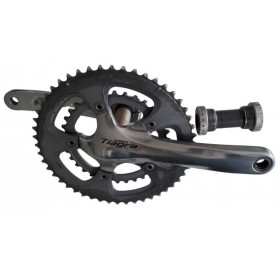 zoom_in
zoom_in
Carbon Drive bicycle belt drive kit
- 1 Item
- Used
€59.99 VAT included
Belt drive bike transmission: a silent and durable alternative to the traditional chain
In recent years, the belt drive bike transmission has gained popularity among urban cyclists and long-distance bike tourers. Quiet, clean, and virtually maintenance-free, this technology is growing fast—especially with the rise of systems like Gates Carbon Drive. But how does a belt drive actually differ from a traditional chain? What are its advantages, limitations, and how do you install a bike belt drive kit? Here’s everything you need to know.
What is a belt drive bike transmission ?
Unlike a traditional bike drivetrain that uses a metal chain, a belt drive system uses a reinforced carbon belt and specialized sprockets made of steel or aluminum. Originally developed for motorcycles and cars, this technology has been adapted to many types of bikes: city bikes, hybrid bikes, e-bikes, and touring bikes.
The Gates Carbon Drive system is the market leader. Built around an ultra-strong carbon fiber belt, it offers excellent durability and efficiency while drastically reducing maintenance needs.
The advantages of a carbon belt drive
1. Silent and smooth
One of the biggest advantages of a belt drive bike transmission is its near-silent operation. No chain rattle, no squeaks from dry links—just a smooth and quiet ride, even over long distances.
2. Low maintenance
No oil, no rust, no chain stretch. Just rinse the belt with water, and you’re good to go. It’s the perfect drivetrain for daily commuting and urban riding.
3. Exceptional longevity
A carbon belt drive can last two to three times longer than a standard bike chain—often over 20,000 km, depending on your riding habits.
4. Clean and safe
No grease means no dirty pants or messy hands. And since the belt has no sharp teeth or moving parts, it’s safer around kids and pets.
What’s included in a bike belt drive kit ?
Switching to a belt drive isn’t just a matter of swapping out your chain—it requires a complete system designed for this purpose.
A typical bike belt drive kit includes :
-
A Gates Carbon Drive belt (or similar brand)
-
A front chainring with belt-compatible teeth
-
A rear sprocket, often mounted on an internal gear hub
-
A frame designed for belt use, with a rear dropout or split stay to allow the belt to pass through
Important: Unlike a chain, a belt cannot be broken and rejoined. Your bike frame must have a belt opening or be specifically built to accommodate a belt drive.
What types of bikes are suitable for belt drive ?
-
Urban and commuter bikes: ideal for low-maintenance, clean daily rides.
-
Electric bikes (e-bikes): works perfectly with mid-drive motors (Bosch, Shimano) and internal gear hubs (Rohloff, Enviolo, Shimano Nexus).
-
Touring and adventure bikes: a reliable drivetrain system that lasts thousands of kilometers with no fuss.
Limitations to keep in mind
-
Requires a compatible frame: standard bike frames usually can’t be retrofitted easily.
-
Not compatible with traditional derailleurs: belt drives work only with internal gear hubs or gearbox systems like Pinion.
-
Higher upfront cost: while a bike belt drive kit costs more than a chain system, the long-term savings in maintenance and replacement are significant.
Bottom line: is a belt drive worth it ?
If you’re looking for a bike drivetrain that’s clean, durable, quiet, and low-maintenance, a belt drive transmission is a great investment. While it requires a compatible frame, it offers unmatched comfort and reliability—whether you’re commuting to work or cycling across continents.





